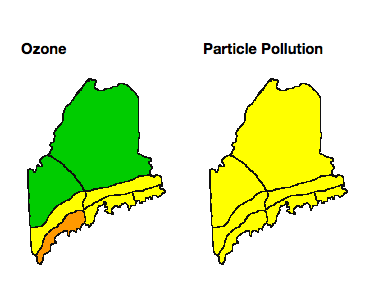Maine is in the midst of its first string of “bad air” days in a couple of years thanks to a weather pattern that has brought a late-summer surge of hot air and high humidity to the region.
The Maine Department of Environmental Protection said ground-level ozone was expected to reach unhealthy levels for a second straight day on Tuesday and potentially stretch into Wednesday in southern coastal areas, prompting the department to issue air quality alerts urging caution among groups sensitive to air pollution. The combination of warmer temperatures, high humidity and potentially unhealthy air led some high schools to alter their first fall sports practices, while officials at Acadia National Park were advising visitors about the conditions.
“Essentially my trainer becomes the guy who can tell them whether they can practice outside or inside,” said Rich Buzzell, athletic director at Marshwood High in South Berwick. “He watches the heat index and if it gets to a point where it’s dangerous to practice, he lets everyone know.”
Overall, much of Maine has experienced a normal-to-moderate summer so far.
Average temperatures in Portland were roughly 0.5 degrees above normal for the first-half of August but were normal in July and a full 2 degrees below normal in June, according to the National Weather Service. As of Monday, Portland had recorded only two days when temperatures crested 90 degrees – on May 26 and July 12 – but Monday’s higher humidity made temperatures in the mid- to upper-80s feel warmer.
Monday’s unhealthy air advisories were the first such events since 2013, although anticipated changes to federal ozone standards are likely to trigger more advisories in Maine and nationally in the future.
A critical component of the upper atmosphere, ozone can cause asthma attacks and breathing problems when concentrations rise too high on the ground. Ground-level ozone is produced when pollution from vehicle or smokestack emissions, such as nitrogen oxide and volatile organic compounds, combines with intense sunlight and oxygen.
While children, the elderly and the infirm are especially vulnerable, officials warn that even healthy adults may experience more shortness of breath, irritation or other effects when exercising or exerting themselves outside.
Ground-level ozone levels were anticipated to reach unhealthy levels for sensitive groups and active adults again Tuesday for southern coastal Maine stretching from Kittery to Wiscasset. Air quality conditions in the rest of midcoast and Down East Maine, as well as many inland areas, were expected to be “moderate” Tuesday, according to the DEP. Particle pollution levels were expected to be “moderate” for the entire state, a designation that comes with a recommendation that people sensitive to air pollution should reduce prolonged or heavy exertion outdoors.
More than 2 million people visit Acadia National Park every year to take in the sweeping vistas from the rocky coastline and from atop Cadillac Mountain and other peaks. Yet Acadia’s mountainous terrain and location along the coast means the park is more susceptible to air pollution drifting up the Eastern Seaboard.
Park staff was advising visitors Monday about the air quality at visitor centers and via the park’s Facebook page and Twitter account. There were no restrictions on activities.
“People need to use the information to make that determination themselves,” Acadia public information officer John Kelly said.
Southern Maine high schools were closely watching weather conditions – and in particular the heat index that considers the combination of air temperature and humidity level – because Monday marked the beginning of the practice season for many fall sports programs. Many teams practiced early in the day, before it became too hot, and others weren’t scheduled until the evening.
Marshwood High athletic trainer Greg Abbott uses a heat index monitor and advises the coaches as to what they can do. Buzzell, Marshwood’s athletic director, said the school also has set up extra water stations throughout its practice fields.
“If the heat index is at a certain level, he tells them they have to take a water break every five minutes, or 10 minutes, or 15, whatever it calls for,” Buzzell said.
At Mt. Ararat High in Topsham, the coaching and training staff use the AccuWeather website as a gauge. It provides a RealFeel temperature, which takes into account the humidity, angle of the sun, time of day, cloud cover and wind, and makes suggestions based on the conditions.
Athletic Director Todd Sampson said athletic trainer Kate Anagnostis monitors the conditions and lets coaches know how to proceed. Sampson said all practices went well Monday morning, but by the afternoon conditions were such that “we would have no outside activities at all.” Sampson also took to Twitter over the weekend to remind his athletes to start hydrating themselves for Monday’s practices.
“And they’ve got to start hydrating right now to be ready for (Tuesday’s) practices,” he said.
Gary Stevens, the athletic director at Thornton Academy in Saco, said his staff followed “standard protocols” for the heat. That meant more water breaks and rest periods, and trying to find shade to conduct drills or meetings in. Stevens said the football team, which was returning for a second session Monday evening, ended its morning practice early.
FEWER ‘BAD AIR’ DAYS
Maine is experiencing fewer unhealthy air days as a result of stricter pollution controls in the state and the region. From 1997 to 2002, Maine averaged 19 days each year when at least one air quality monitor registered ground-level ozone concentrations above the federal standard of 75 parts per billion during an eight-hour period, with the high coming in 2002 when the state recorded 28 unhealthy air days. That number has remained in the single-digits since 2008, however, and the state did not experience any unhealthy ozone days last year, according to data supplied by the DEP.
Maine has reduced in-state emissions of key smog-causing pollutants by more than half during the past 30 years, according to the DEP. But Maine’s location along the Eastern Seaboard means that many of the pollutants that contribute to smog originate in Southern and Midwestern states with laxer air pollution standards and more coal-burning power plants.
In September 2014, the U.S. Environmental Protection Agency proposed reducing the ground-level ozone standard from 75 parts per billion to between 65 and 70 parts per billion in response to years of concerns by health experts that 75 parts per billion does not adequately protect public health. The agency also solicited on a 60 parts per billion standard advocated by many health groups.
The federal agency is expected to finalize those standards later this year. As a result, Maine is expected to experience more unhealthy air days and could be required to take additional regulatory steps to bring Maine counties into compliance with the stricter federal standards, said Andrew Johnson with the DEP’s Bureau of Air Quality.
Nonetheless, DEP officials and public health groups have consistently supported the lower standards because they would force stricter pollution controls in upwind states that contribute to Maine’s air quality problems.
“How far (the federal standard) will go down is the $50,000 question, but I don’t think there is any question that it will go down,” Johnson said. “I have been monitoring air quality for 37 years now and I can definitely say first-hand that we have reduced the amount of pollution that contributes to the formation of ozone” in the state.
Staff Writer Mike Lowe contributed to this report.
Send questions/comments to the editors.







Success. Please wait for the page to reload. If the page does not reload within 5 seconds, please refresh the page.
Enter your email and password to access comments.
Hi, to comment on stories you must . This profile is in addition to your subscription and website login.
Already have a commenting profile? .
Invalid username/password.
Please check your email to confirm and complete your registration.
Only subscribers are eligible to post comments. Please subscribe or login first for digital access. Here’s why.
Use the form below to reset your password. When you've submitted your account email, we will send an email with a reset code.